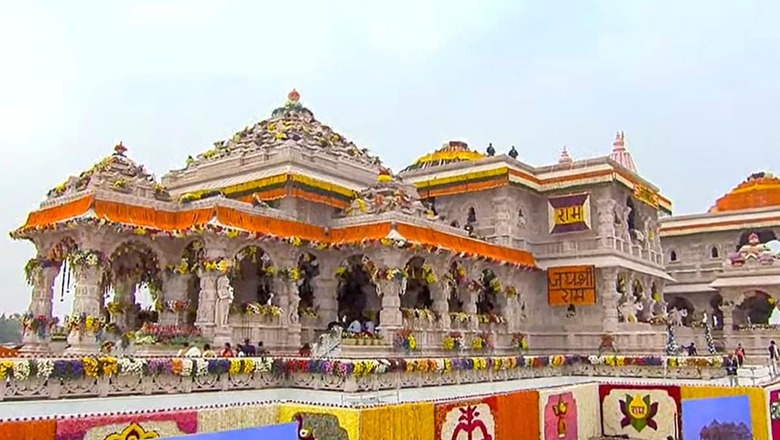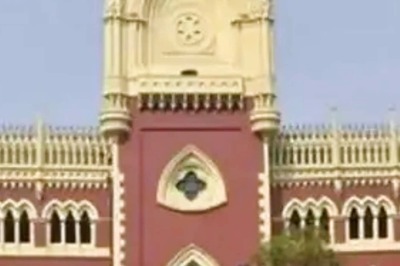
views
The Ram Temple in Ayodhya, which emerged as one of the main centres of Hindu devotees after the grand ‘Pran Pratishtha’ ceremony of Lord Ram earlier this month, is not only built to last 1,000 years but can also withstand the biggest earthquake that occurs once in 2,500 years.
A series of scientific studies of the Ayodhya site, including geophysical characterisation, geotechnical analysis, foundation design vetting, and 3D structural analysis and design was conducted by the CSIR-Central Building Research Institute (CSIR-CBRI) – Roorkee.
Opened for the public on January 23, the temple has been drawing devotees in huge numbers and over 16 lakh people have sought Lord Ram’s blessings.
Ayodhya on ‘Crowd’ Nine: Braving Biting Cold, Devotees Throng Ram Temple; 19 Lakh Visitors in 6 Days
“The scientific study was done to ensure the structural safety of the temple for the Maximum Considered Earthquake, equivalent to a 2,500-year return period,” Debdutta Ghosh, a senior scientist at CSIR-CBRI said.
Ghosh and Manojit Samanta — coordinators of the Centre of Excellence for Conservation of Heritage Structures at CSIR-CBRI — led the teams in reviewing the foundation design and monitoring, conducting 3D structural analysis and design the Ram Mandir.
Ghosh said the geophysical characterisation process involved a Multi-Channel Analysis of Surface Waves (MASW) to estimate primary wave velocity, along with electrical resistance tomography to identify anomalies, water saturation zones and water tables. These findings served as crucial inputs for a site-specific response for underground investigations and estimation of seismic design parameters, he said.
The CSIR-CBRI also vetted soil investigation schemes, foundation design parameters, excavation schemes and recommendations for foundation and structure monitoring. Ghosh said the structural design was recommended after simulating more than 50 computer models and analysing those under different loading conditions for its optimal performance, architectural appeal and safety.
The entire superstructure has been constructed using Bansi Paharpur sandstone, embodying a dry jointed structure with no steel reinforcement, designed for a lifespan of 1,000 years, he said.
The superstructure material — Bansi Paharpur sandstone — has been tested at the Centre to evaluate the engineering properties that was used as input for structural analysis.
Specialised brick with compressive strength of more than 20 MPa (mega pascals), or approximately 2,900 pounds per square inch (psi), at 28 days of curing under standard conditions, has been used in the structures, Ghosh said.
Ayodhya & Earthquake
A total of 59% of the land mass of India (covering all states of India) is prone to earthquakes of different intensities, the central government informed the Palriament in 2021. As per the seismic zoning map of the country, the total area is classified into four seismic zones. Zone V is seismically the most active region, while zone II is the least. Approximately 11% area of the country falls in zone V, 18% in zone IV, 30% in zone III and remaining in zone II.
Ayodhya, which is located around 150 km from Uttar Pradesh’s capital Lucknow, falls in Zone III. The district is around 700 km away from Delhi, which is in Zone IV, which is at ‘high risk’. Delhi-NCR is known to be an earthquake-prone area due to high seismic activity. It is unique in its placement that it trembles every three to four months as well as whenever there is an earthquake in the Himalayan region.
Facts About Ayodhya Ram Mandir
- The Ram Mandir complex area spans 70 acres, with the main temple area covering 2.7 acres and a built-up area of about 57,400 square feet.
- The design of the temple is rooted in the traditional Nagara style. Its length (east-west) is 380 feet; width is 250 feet and height is 161 feet; and is supported by a total of 392 pillars and 44 doors.
- The use of steel or iron has been avoided in the construction of the temple structure. Instead, the Mandir has been constructed employing the country’s indigenous technology and traditional construction materials, aligning with India’s age-old building practices and demonstrating a commitment to sustainability.
- For protection against ground moisture, a 21-foot-high plinth has been constructed using granite.
- The entire structure has been valued at Rs 1,800 crore. It is being financed by the Shri Ram Janmabhoomi Teerth Kshetra Trust, which has collected over Rs 3,500 crore in donations from across India and abroad.
(With PTI inputs)




















Comments
0 comment